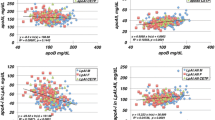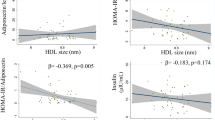Abstract
Objective: Oxidized low-density liporotein (LDL) autoantibodies (oxLDLab), apolipoprotein E (apoE) phenotype, postprandial triglyceride changes and LDL size are suggested to be risk factors for coronary artery disease (CAD). Our aim was to study the interaction between these new risk factors among patients with CAD and healthy controls.Methods: oxLDLab from 31 men with angiographically verified CAD and 31 healthy men were analyzed by enzyme-linked immunosorbent assay. Iso-electric focusing and immunoblotting were used for apoE phenotyping. Triglyceride level was measured after 12 h of fasting and 3, 5 and 7 h after a high-fat meal. Nondenaturing gradient gel electrophoresis was used to separate LDL particles according to size.Results: oxLDLab levels increased according to apoE phenotype in the following order: E2<E3<E4 (p=0.004, ANOVA). The postprandial response of triglycerides, the size of LDL particles and the concentration of LDL and high-density lipoprotein (HDL) cholesterol did not differ between apoE phenotypes, and the use of these variables as covariates did not change the statistically significant difference in oxLDLab levels between apoE phenotypes (p=0.01, ANCOVA). oxLDLab levels did not differ between the patient and control groups.Conclusion: We found an association between apoE allele ɛ2 and decreased levels of oxLDLab, which was independent of the postprandial response of triglycerides, the size of LDL particles and plasma LDL and HDL cholesterol levels. The mechanism by which apoE affects oxidation of LDL remains unknown.
Similar content being viewed by others
References
Austin MA. Triglyceride, small, dense low-density lipoprotein, and the atherogenic lipoprotein phenotype. Curr Atheroscler Rep 2:200–207;2000.
Ayaori M, Ishikawa T, Yoshida H, Suzukawa M, Nishiwaki M, Shige H, Ito T, Nakajima K, Higashi K, Yonemura A, Nakamura H. Beneficial effects of alcohol withdrawal on LDL particle size distribution and oxidative susceptibility in subjects with alcohol-induced hypertriglyceridemia. Arterioscler Thromb Vasc Biol 17:2540–2547;1997.
Bakalova R, Zhelev Z, Goudev A, Ribarov S, Nachev C. Serum level of IgG autoantibodies against oxidized low density lipoproteins and lag-phase of serum oxidation in coronary heart disease — inverse correlation. Gen Physiol Biophys 18:87–97;1999.
Chisolm GM, Steinberg D. The oxidative modification hypothesis of atherogenesis: An overview. Free Radic Biol Med 28:1815–1826;2000.
Dallongeville J, Tiret L, Visvikis S, O'Reilly DS, Saava M, Tsitouris G, Rosseneu M, DeBacker G, Humphries SE, Beisiegel U. Effect of apo E phenotype on plasma postprandial triglyceride levels in young male adults with and without a familial history of myocardial infarction: The EARS II study. European Atherosclerosis Research Study. Atherosclerosis 145:381–388;1999.
Dart A, Sherrard B, Simpson H. Influence of apo E phenotype on postprandial triglyceride and glucose responses in subjects with and without coronary heart disease. Atherosclerosis 130:161–170;1997.
Dart AM, Cooper B. Independent effects of Apo E phenotype and plasma triglyceride on lipoprotein particle sizes in the fasting and postprandial states. Arterioscler Thromb Vasc Biol 19:2465–2473;1999.
Enbergs A, Burger R, Reinecke H, Borggrefe M, Breithardt G, Kerber S. Prevalence of coronary artery disease in a general population without suspicion of coronary artery disease: Angiographic analysis of subjects aged 40 to 70 years referred for catheter ablation therapy. Eur Heart J 21:45–52;2000.
Erkkila AT, Narvanen O, Lehto S, Uusitupa MI, Yla-Herttuala S. Autoantibodies against oxidized low-density lipoprotein and cardiolipin in patients with coronary heart disease. Arterioscler Thromb Vasc Biol 20:204–209;2000.
Friedewald WT, Levy RI, Fredrickson DS. Estimation of the concentration of low-density lipoprotein cholesterol in plasma, without use of the preparative ultracentrifuge. Clin Chem 18:499–502;1972.
Fukumoto M, Shoji T, Emoto M, Kawagishi T, Okuno Y, Nishizawa Y. Antibodies against oxidized LDL and carotid artery intima-media thickness in a healthy population. Arterioscler Thromb Vasc Biol 20:703–707;2000.
George J, Afek A, Gilburd B, Levkovitz H, Shaish A, Goldberg I, Kopolovic Y, Wick G, Shoenfeld Y, Harats D. Hyperimmunization of apo-E-deficient mice with homologous malondialdehyde low-density lipoprotein suppresses early atherogenesis. Atherosclerosis 138:147–152;1998.
George J, Harats D, Bakshi E, Adler Y, Levy Y, Gilburd B, Shoenfeld Y. Anti-oxidized low density lipoprotein antibody determination as a predictor of restenosis following percutaneous transluminal coronary angioplasty. Immunol Lett 68:263–266;1999.
Haffner SM, Stern MP, Miettinen H, Robbins D, Howard BV. Apolipoprotein E polymorphism and LDL size in a biethnic population. Arterioscler Thromb Vasc Biol 16:1184–1188;1996.
Hayek T, Oiknine J, Brook JG, Aviram M. Increased plasma and lipoprotein lipid peroxidation in apo E-deficient mice. Biochem Biophys Res Commun 201:1567–1574;1994.
Hulthe J, Bokemark L, Fagerberg B. Antibodies to oxidized LDL in relation to intimamedia thickness in carotid and femoral arteries in 58-year-old subjectively clinically healthy men. Arterioscler Thromb Vasc Biol 21:101–107;2001.
Jansen H, Ghanem H, Kuypers JH, Birkenhager JC. Autoantibodies against malondialdehyde-modified LDL are elevated in subjects with an LDL subclass pattern B. Atherosclerosis 115:255–262;1995.
Jolivalt C, Leininger-Muller B, Bertrand P, Herber R, Christen Y, Siest G. Differential oxidation of apolipoprotein E isoforms and interaction with phospholipids. Free Radic Biol Med 28:129–140;2000.
Kreisberg RA. Diabetic dyslipidemia. Am J Cardiol 82:67U-73U,discussion 85U–86U; 1998.
Lehtimaki T, Lehtinen S, Solakivi T, Nikkila M, Jaakkola O, Jokela H, Yla-Herttuala S, Luoma JS, Koivula T, Nikkari T. Autoantibodies against oxidized low density lipoprotein in patients with angiographically verified coronary artery disease. Arterioscler Thromb Vasc Biol 19:23–27;1999.
Lehtimäki T, Moilanen T, Viikari J, Akerblom HK, Ehnholm C, Ronnemaa T, Marniemi J, Dahlen G, Nikkari T. Apolipoprotein E phenotypes in Finnish youths: A cross-sectional and 6-year follow-up study. J Lipid Res 31:487–495;1990.
Lopes-Virella MF, Virella G, Orchard TJ, Koskinen S, Evans RW, Becker DJ, Forrest KY. Antibodies to oxidized LDL and LDL-containing immune complexes as risk factors for coronary artery disease in diabetes mellitus. Clin Immunol 90:165–172;1999.
Makimattila S, Liu ML, Vakkilainen J, Schlenzka A, Lahdenpera S, Syvanne M, Mantysaari M, Summanen P, Bergholm R, Taskinen MR, Yki-Jarvinen H. Impaired endothelium-dependent vasodilation in type 2 diabetes. Relation to LDL size, oxidized LDL, and antioxidants. Diabetes Care 22:973–981;1999.
Mironova MA, Klein RL, Virella GT, Lopes-Virella MF. Anti-modified LDL antibodies, LDL-containing immune complexes, and susceptibility of LDL to in vitro oxidation in patients with type 2 diabetes. Diabetes 49:1033–1041;2000.
Miyata M, Smith JD. Apolipoprotein E allelespecific antioxidant activity and effects on cytotoxicity by oxidative insults and beta-amyloid peptides. Nat Genet 14:55–61;1996.
Nicoletti A, Caligiuri G, Hansson GK. Immunomodulation of atherosclerosis: Myth and reality. J Intern Med 247:397–405;2000.
Nikkila M, Solakivi T, Lehtimaki T, Koivula T, Laippala P, Astrom B. Postprandial plasma lipoprotein changes in relation to apolipoprotein E phenotypes and low density lipoprotein size in men with and without coronary artery disease. Atherosclerosis 106:149–157;1994.
Orchard TJ, Virella G, Forrest KY, Evans RW, Becker DJ, Lopes-Virella MF. Antibodies to oxidized LDL predict coronary artery disease in type 1 diabetes: A nested case-control study from the Pittsburgh Epidemiology of Diabetes Complications Study. Diabetes 48:1454–1458;1999.
Paiker JE, Raal FJ, von Arb M. Auto-antibodies against oxidized LDL as a marker of coronary artery disease in patients with familial hypercholesterolaemia. Ann Clin Biochem 37:174–178;2000.
Palinski W, Witztum JL. Immune responses to oxidative neoepitopes on LDL and phospholipids modulate the development of atherosclerosis. J Intern Med 247:371–380;2000.
Puurunen M, Manttari M, Manninen V, Tenkanen L, Alfthan G, Ehnholm C, Vaarala O, Aho K, Palosuo T. Antibody against oxidized low-density lipoprotein predicting myocardial infarction. Arch Intern Med 154:2605–2609;1994.
Saarelainen S, Lehtimaki T, Nikkila M, Solakivi T, Nieminen MM, Jaakkola O. Association between apolipoprotein E alleles and autoantibodies against oxidised low-density lipoprotein. Clin Chem Lab Med 38:477–478;2000.
Shoji T, Nishizawa Y, Fukumoto M, Shimamura K, Kimura J, Kanda H, Emoto M, Kawagishi T, Morii H. Inverse relationship between circulating oxidized low density lipoprotein (oxLDL) and anti-oxLDL antibody levels in healthy subjects. Atherosclerosis 148:171–177;2000.
Siest G, Pillot T, Regis-Bailly A, Leininger-Muller B, Steinmetz J, Galteau MM, Visvikis S. Apolipoprotein E: An important gene and protein to follow in laboratory medicine. Clin Chem 41:1068–1086;1995.
Smith JD, Miyata M, Poulin SE, Neveux LM, Craig WY. The relationship between apolipoprotein E and serum oxidation-related variables is apolipoprotein E phenotype dependent. Int J Clin Lab Res 28:116–121;1998.
van de Vijver LP, Steyger R, van Poppel G, Boer JM, Kruijssen DA, Seidell JC, Princen HM. Autoantibodies against MDA-LDL in subjects with severe and minor atherosclerosis and healthy population controls. Atherosclerosis 122:245–253;1996.
Witztum JL, Steinberg D. Role of oxidized low density lipoprotein in atherogenesis. J Clin Invest 88:1785–1792;1991.
Zhao SP, Verhoeven MH, Vink J, Hollaar L, van der Laarse A, de Knijff P, van't Hooft FM. Relationship between apolipoprotein E and low density lipoprotein particle size. Atherosclerosis 102:147–154;1993.
Author information
Authors and Affiliations
Rights and permissions
About this article
Cite this article
Metso, S., Nikkilä, M., Laippala, P. et al. Oxidized LDL autoantibodies are related to apolipoprotein E phenotype, independently of postprandial change in plasma triglycerides and LDL size, among patients with angiographically verified coronary artery disease and healthy controls. J Biomed Sci 10, 345–351 (2003). https://doi.org/10.1007/BF02256454
Received:
Accepted:
Issue Date:
DOI: https://doi.org/10.1007/BF02256454




